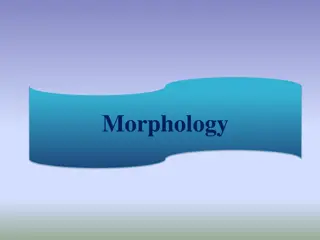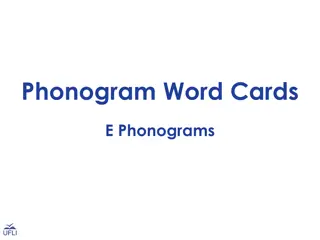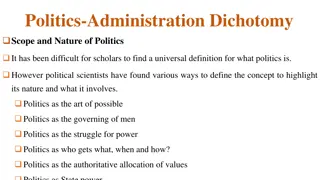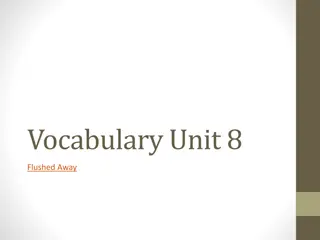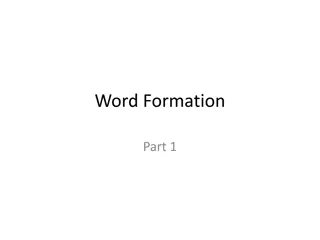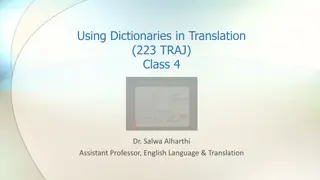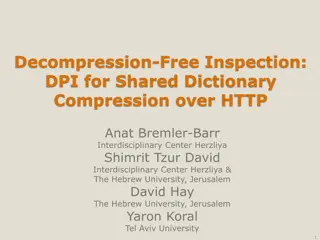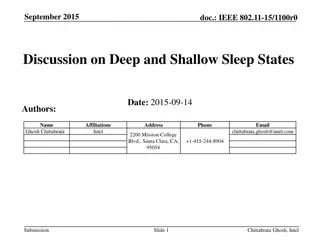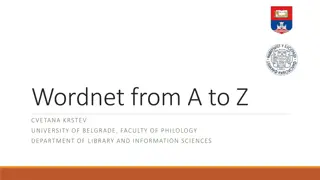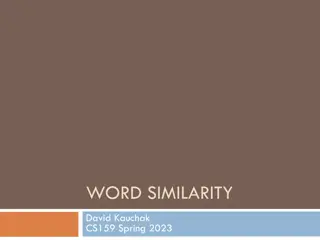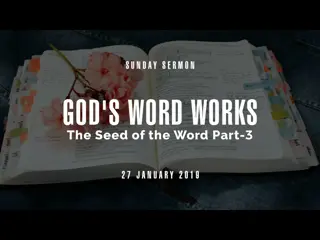Understanding the Structure of a Dictionary and Word Definitions
Explore the macrostructure and microstructure of a dictionary, including the front matter, body entries, and end matter. Learn about stress, part of speech, synonyms, cross-references, collocations, and more. Additionally, uncover the definition and characteristics of a word, addressing the query of whether phrases like "air mail" are considered one or two words.
Download Presentation

Please find below an Image/Link to download the presentation.
The content on the website is provided AS IS for your information and personal use only. It may not be sold, licensed, or shared on other websites without obtaining consent from the author. Download presentation by click this link. If you encounter any issues during the download, it is possible that the publisher has removed the file from their server.
E N D
Presentation Transcript
The structure of a dictionary: Macrostructure overall structural organization of volume, typically: Front matter, introduction, user guidelines; (before the A letter) Body entries and definitions, typically organized alphabetically; (from A-z) End matter appendices and additional information, e.g. personal names, place names, loan items etc. (after the z)
The structure of a dictionary: Microstructure internal structure of dictionary entry blocks, typically: Headword- the word you are looking up. It is always in bold type. Entry- the information on the word you are looking up. Pronunciation- tells you how to say the word. Found in (parentheses).
Stress: stress is very important, because it is hard to understand a word pronounced with the wrong stress. Part of speech- tells you how the word is used in a sentence (n=noun, v=verb, adj=adjective, adv=adverb). British and American vocabulary or pronunciation: the British word (labelled BrE) and the American (labelled NAmE or (US to distinguish between American and Canadian words).
Spelling Semantic specification Synonyms and opposites: some dictionary entries also provide a list of synonyms (syn), words with similar meanings; and opposite meanings (opp).
Cross-references: to related items: some dictionary entries contain cross-references. Within the entry, you will find the word see, compare, or var (variation) of that directs you to another dictionary entry which will give you more information about the word you first looked up. Collocations, co-occurrence strings: certain words that are typically used with other words. For example, we say a tall tree but a high mountain . These words are called collocates. Register: the dictionary contains a number of labels which tell you about how formal a word is, and in what situations you can use it. Here are some of these words: technical informal disapproving ironic formal taboo Usage with examples Etymological: this tells you the history of the word, and what language it came from.
What is a Word What is a Word https://youtu.be/iEsYD4yVSBA
What is actually a WORD WORD A word is a group of characters placed together with spaces or punctuation marks before or after. But what about an expression like: air mail Is it two words? Is airline one word What about air-bed The user will have to look in two or three different places in the dictionary to find the word as the user cannot know in advance whether a word like air mail is entered under air or under mail.
Nature of Headwords What is a word: are the following words? want, wanting, wanted, war chest, war crime, courthouse, wannabe, half-baked 1. Orthographic word (relating to spelling) written word surrounded by spaces; but what about compounds, hyphenated forms etc. 2. Phonological word sequence of sounds that forms phonological unit (determined by rules of syllable structure, stress, etc) Lexeme item of vocabulary that may occur as dictionary headword. Lexemes can be more than one orthographic word i.e. a word or several words that have a meaning that is not expressed by any of its separate parts 3.
Lexeme is an abstract concept it is the set of word forms that comprise a paradigm of related words forms, eg. sing sings singing - sang sung (cf. talk talks talking talked talked) regular and irregular paradigms; A lexeme can have many different forms. Word-form is inflectional variant of lexeme i.e. word forms have the same lexeme e.g. runs, ran, running are forms of the same lexeme (run). However, the derivative (runner ) has a different lexeme. * A headword is typically a citation form of a lexeme i.e. represents a lexeme.
The Lemma The lemma functions as a representative of a linguistic sign; in a dictionary, it represents the lexical item described in the individual dictionary entry. In a dictionary having an alphabetical macrostructure, the lemma also has the function of determining the position of the entry in the lemma list. The lemma helps users to find the information provided about the lemma sign. In some cases the information is given as a cross reference to another lemma.
A lexeme Vs A Lemma A lexeme is a unit of meaning, and can be more than one word. A lexeme is the set of all forms that have the same meaning, while lemma refers to the particular form that is chosen by convention to represent the lexeme. In English, for example, run, runs and running are forms of the same lexeme, but run is the lemma.
Entry Entry Order Order Dictionaries of alphabetic languages list words in alphabetical order. With non-alphabetic languages, it may be different. The order in a dictionary with ideographic entries i.e. graphic symbols that represent an idea rather than a group of letters; such as Chinese character is often troublesome and controversial because each character has different readings.
Spelling and word division Spelling and word division Spelling is one of the most frequent reasons for consulting a dictionary. Information about spelling is conveyed by the lemma. A user who is not sure about the spelling of a certain word may need help to find the right entry in the dictionary. In electronic dictionaries, there is no need to search in various places in order to find the correct spelling since the dictionary automatically displays a list of suggestions if an incorrect or incomplete spelling is given.
WordDivision Information about word division may serve different purposes. In most cases it is a matter of showing where the word can be divided at the end of a line of writing (orthographic word division), but there are also cases where word division is concerned not only with orthography but with word formation as well. Word division information is useful in L1 dictionaries as they are intended for production. Word division information may promote vocabulary building.
There are several types of word-division marker; e.g. capitalization Dictionaries do not always agree on the position of word-division points. For example, in English there is a disagreement not only between British and American dictionaries, but also between different British dictionaries.
Pronunciation Pronunciation The need for pronunciation information in dictionaries varies between languages. In Finnish, there is a complete one -to-one correspondence between spelling and pronunciation and the stress is always on the first syllable. The pronunciation of English is very little in agreement with the spelling. The need for pronunciation information varies between different types of dictionaries. Pronunciation is usually shown in monolingual dictionaries. In L1 (object language is the user s native language)dictionaries, pronunciation information is needed only for words that may cause difficulties. In L2 (object language is not the user s native language) dictionaries, pronunciation must be shown for all words.
Types of pronunciation information: Which sounds occur? What is the length of the sounds? What is the position of the stress? What is the tone used? This information is conveyed to the user in two main types: 1. Visually, by means of written characters on a book page or a computer screen. 2. Auditorily, this feature is offered by some electronic dictionaries.
Equivalents Equivalents The purpose of the bilingual dictionary is to provide lexical items in one language( the source language) with counterparts (equivalents) in another language (the target language) that are as near as possible with regard to meaning and usage. In bilingual lexicography, there are certain restriction and problems originating from the differences between the two linguistic systems.
Different concept formation in different Different concept formation in different languages languages The conceptual world evolves differently in different languages as a result of cultural and other differences between the areas where the languages are used. The number of concepts within a certain conceptual field may differ. For example,in the Eskimo language, there is a large stock of concepts relating to snow while Arabic has a wide range of concepts relating to camels.
Some Snow Terms Artificial Snow: Snow manufactured by snow cannons or guns, which create tiny granules like hair or grits. These machines are becoming cheaper with increased technology. Ball Bearings: Little firm balls of snow that form around or under skis. Blowing Snow: Grounded snow that has been moved around by the wind. Blue: Clear ice, the ground is visible underneath it. Breakable Crust: The top is frozen solid, but underneath there is soft powder. Brown Snow: Mud showing through, often during springtime. Bulletproof: White, but so densely packed it is hard to put dents through it. California Concrete: Heavy wet snow that is created by a Pacific storm. Chokable: Powder that is so fine and deep you could drown or "choke." Chop: Freshly fallen powder that has been skied on enough to be chopped up, but there are few bumps. Chopped Powder: Powder snow that has been "cut up" by other skiers/snowboarders. Chowder: Heavy, wet, lumpy snow. Colorado Super Chunk: Heavy wet snow about two days after a spring storm. Cornice: A formation of windblown snow, also known as an overhang. It is important to recognize cornice in alpine skiing and climbing because it is often unstable and hard to see from the windward side.
: . : . : . : . : . : . : . : . : . : . : . : . : . : . : . : . : . : . : . : . ) ( : . : . : . :





